The intersection between watches and wheels
Car enthusiasts often appreciate the mechanical engineering and artistry of watches and autos in equal measure. Hagerty’s own podcast ‘The Viva Bastardo Show’ frequently discusses the intersection of car and watch collecting. However, most attempts to market the two as a package achieve Lincoln Blackwood-level infamy. Indeed, co-branded car/watch mashups often carry the same tragicomic stigma as a “Handling by Lotus” tag hot-glued to the tailgate of an Isuzu Impulse. Skip those trinkets; Tim Mosso, Director of Media and Watch Expert from Watchbox has put together this guide to the best watches for drivers who love cars, car culture, and motorsports.

Rolex Daytona
Consider the Rolex Daytona. Launched in 1963 as the Rolex “Le Mans,” this chronograph’s American target audience dictated a change to “Daytona” before the year was out. A quick motorsports detour is in order…
During the 1950s, Daytona Beach served both as a venue for stock car racing and a pre-Bonneville staging zone for sanctioned speed trials. Many chronographs including Rolex models were used during this period to track everything from stock car events on the sand to the famous manufacturer-sanctioned “flying mile” speed duels. Daytona International Speedway arrived in 1959 to professionalize a U.S. racing scene fast evolving beyond its grassroots origins on the sand.
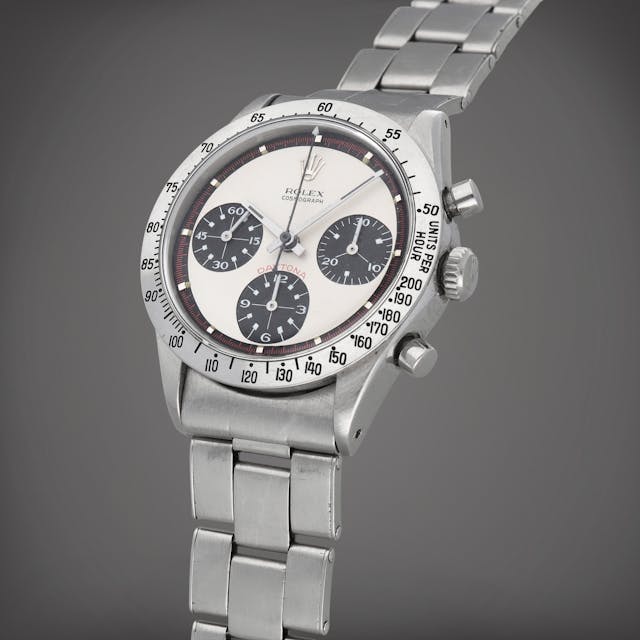
Endurance sports car racing shared space with NASCAR at the high-banked venue, and Rolex was involved from the beginning. Since 1992, the Swiss giant has been the title sponsor of the 24-hour sports car contest held each January. Each of the winning drivers in every class-winning car receives a Rolex Daytona, and it’s one of the most coveted trophies in motorsports.
No watch in the world has been responsible for making more mainstream media headlines than the Rolex Daytona. When The Wall Street Journal publishes an article about years-long waiting lists for watches, the Rolex Daytona is “Exhibit A.” When an all-time-record price paid for a wristwatch occurred at auction in October 2017, a Rolex Daytona reference 6239 once owned by actor/racer Paul Newman did the damage at $17,752,500.
Today’s Rolex Daytona packs modern features while sticking with the success of its core design. The basic 40mm steel Rolex Daytona of 2022 has changed precious little since 1988, and that immunity to obsolescence is part of its appeal. A modern chronometer-certified Rolex automatic caliber 4130 arrived in 2000; better bracelets arrived later in that decade; a black ceramic bezel was added in 2016. But the watch’s appearance rarely changes. Timeless style reinforces the Daytona’s aura as an ageless Olympus for drivers who love watches.
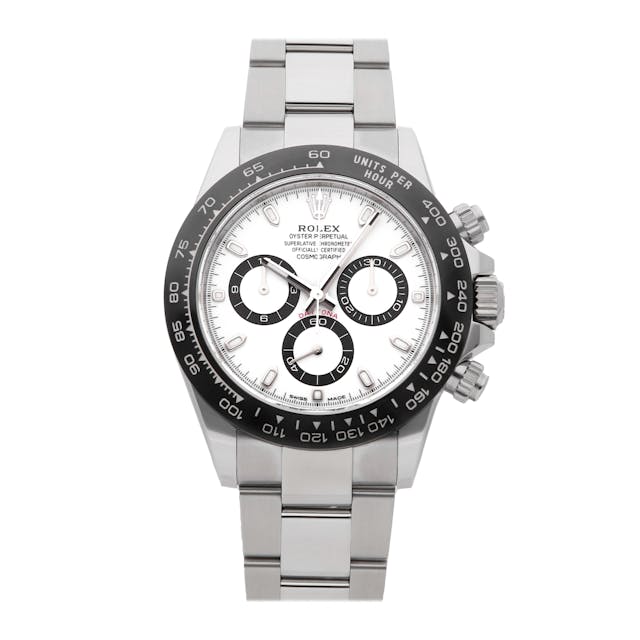
Although the steel Rolex Daytona retails for $14,550, waiting lists for that watch stretch to years at authorized dealers. Secondary markets have inventory readily available, but the going rate of $28,000-$35,000 means that impatient buyers will pay for the convenience. All things considered, the easiest way to get a Rolex Daytona in 2022 might be to win it at the Speedway.
Jaeger-Lecoultre
Most car-watch co-branding deals involve a shotgun marriage of two unrelated companies with no previous acquaintance. But in the early 2000s, horology-snob favorite Jaeger-LeCoultre wasn’t having it.
Jaeger dashboard instruments spent decades on the road and track with Aston Martin prior to the British brand’s 2004 agreement with Le Sentier-based Jaeger-LeCoultre, and JLC put its heart into the deal. While the usual practice with an auto-branded watch is to stick a logo on an existing model, the Amvox series consisted of a freestanding model line of bespoke products bearing an Aston influence. Seven models and their variants spanned the decade-long relationship between the Gaydon-based automaker and its Swiss collaborator.

The Amvox 2 was the best of the series. JLC watchmakers reasoned that drivers and crew at a race had little chance of operating tiny chronograph pushers when racing gloves were involved. The engineering solution to fat fingers was a bold one; build a pivoted case with ball bearing hinges so that taps on the dial could start, stop, and reset the chronograph. The top and bottom of the Amvox 2 case amount to triggers and act as levers to control the chronograph.
At first glance, the Amvox 2 drips with clever automotive design cues, but it doesn’t look like a chronograph due to the absence of chronograph crowns. The system feels as crisp as a rifle bolt, and accidental operation is avoided thanks to a sliding lockout lever on the case flank. Inside the 44mm case, a manufacture JLC caliber 751E provides 65 hours of power reserve and the coveted technical tandem of a column wheel and vertical clutch for precise action.
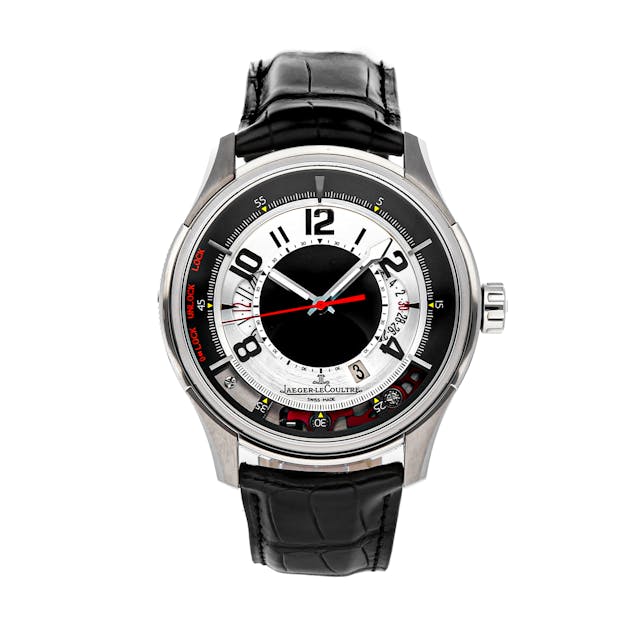
An even more exotic version of the Amvox 2 called the “Transponder” series was capable of remotely operating security systems for at least four generations of Aston Martin anti-theft hardware. Buyer beware; while cool, many of these watches have limited functionality due to Aston’s constant security gear upgrades without reverse compatibility. At this point, those watches are best described as neat chronographs with conversation-starting potential and a slim chance of mating to your actual Aston. Regardless, every version of the Amvox 2 ranks among the most innovative chronographs of the 21st century. Preowned prices of this discontinued model family start around $8,000 for titanium versions and stretch to over $25,000 for the rarest variants and precious metals.
Singer Reimagined
A great car design can be the ideal starting point for a superior watch. When the car in question is an evergreen enthusiast favorite, a smart watch designer will choose enduring visuals to honor his four-wheeled muse. The Porsche 911 is sports car royalty, and the Porsche 911 by Singer Vehicle Design is restomod royalty. Since 2009, no company has done more than Singer to elevate restomodding to the state-of-the-art, and no aftermarket tuner has been more influential in modern times.

Singer brings the same standard to its luxury watches. Company founder Rob Dickinson and former Panerai watch design chief Marco Borraccino established the Singer Reimagined watch brand to construct a timepiece in the spirit of its cars. Borraccino worked with haute horlogerie movement specialist Agenhor of Geneva to create a motorsports chronograph that blends modern technology with a 1970s style sensibility
Unlike the Porsche 911 as modified by Singer, the Track 1 chronograph is a clean-sheet design liberated from the constraints of a donor platform. Its unique stopwatch display places the chronograph hour, minute, and second registers at the dial’s center for maximum legibility. Clock time, which is of secondary importance in racing, can be read on a scrolling display at the base of the dial.

Beneath the hood, so to speak, an automatic Agenhor caliber 6361 hides its winding rotor on the dial side of the movement, and chronograph operation occurs by sharp column wheel action. Agenhor’s unique clutch system has been engineered to provide the elusive combination of a slim lateral clutch, seamless engagement, and compelling aesthetics. Finish is executed to haute horlogerie standards and scanning the movement with a magnifier should be a mandatory drill for owners.
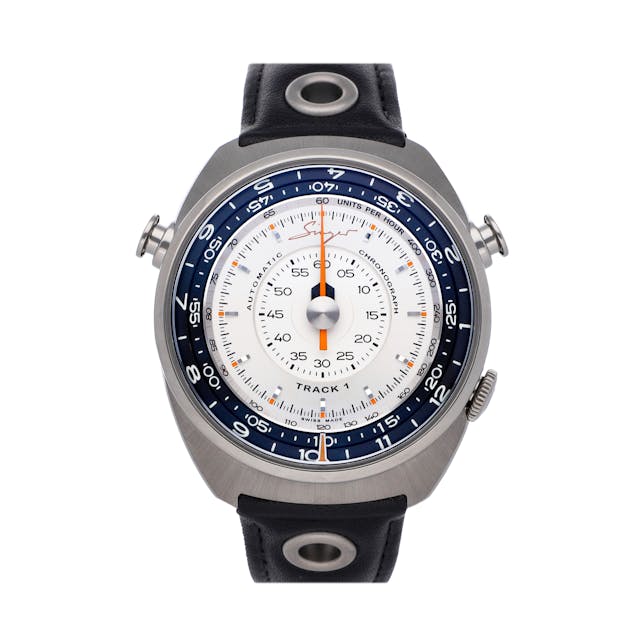
Borraccino drew the Track 1 to read as an anthology of 1970s watch design classics. This period often is discussed as the “golden age” of the racetrack chronograph; it was characterized by tonneau cases, horizontally opposed “bullhead” chronograph pushers, complex case finishes, and “lugless” profiles. The Singer Track 1 incorporates each of these vintage standards while remaining distinctly modern in fit, finish, and engineering. Despite its convincing period aesthetic, the Track 1 enjoys 100-meter water resistance that’s virtually unheard of in true vintage timepieces.
Despite its rarity, the Singer Track 1 exists in sufficient variety with nine versions released that collectors of disparate tastes will find a match. Pale 1N yellow gold satisfies the luxury purist; titanium satisfies the sports watch diehard; black ceramic-aluminum excites the modernist; and forged carbon appeals to the race fan. As a new watch, the Track 1 is priced starting at $33,500 for titanium. Preowned price ranges span $32,000 to $60,000 depending on the rarity and desirability of the variant.
Ressence
Restomods and luxury watches might be having a moment, because Lancia specialist Automobili Amos conceived its own special edition sports watch to match Singer’s Track 1. By pairing with Belgian-Swiss hybrid Ressence, racer Eugenio Amos’ outfit crafted a watch designed specifically for use with his signature Lancia Delta HF Integrale-based “Futurista.”

Ressence designs its watches in Antwerp and builds them in Switzerland, but the Type 5X Automobili Amos receives a forceful injection of Italian style. While the standard Type 5 is a dive watch with an oil-filled time display, the 5X “Amos” recalibrates the dive bezel to time the recommended engine warm-up and cool-down intervals for the $350,000 Futurista.
Like the rally-inspired Lancia Delta HF Integrale, the Type 5X is a formidable feat of engineering. Its dial sits in a sealed bath of oil that renders the Ressence Orbital Convex System time display essentially maintenance-free; it’s lubricated for life. Because the oil and sapphire crystal over the time display have the same index of refraction, the Type 5X can be read clearly from any angle – including under water.
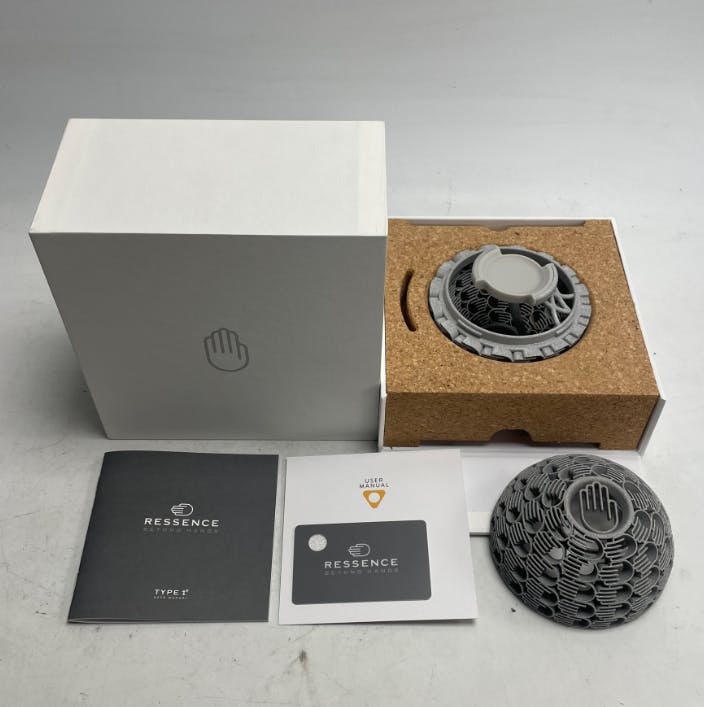
The owner views the hours, minutes, seconds, and a thermometer that indicates the acceptable temperature range in which to wear the watch. Internal bellows permit expansion and contraction of the oil across a broad range of conditions. Just as the Type 5X keeps fluids in, its dive watch roots help to keep other fluids out to the extent of a 100-meter water test rating.
Unlike a conventional watch, the Type 5X has no crown for setting and winding; all of this is done with the rotating case back. Ressence uses a simple Swiss ETA automatic caliber 2824-2 movement to power the Type 5X, and a magnetic coupling links the tractor movement to the sealed oil display at the top of the watch. Because accidental displacement of the minute hand might shorten the indicated Lancia turbocharger preparation period, a case lock prevents operation of the setting mechanism when not in use. New retail for the 5X was $36,500, and the occasional preowned example tends to surface for between original MSRP and $50,000 a handful of times per year.
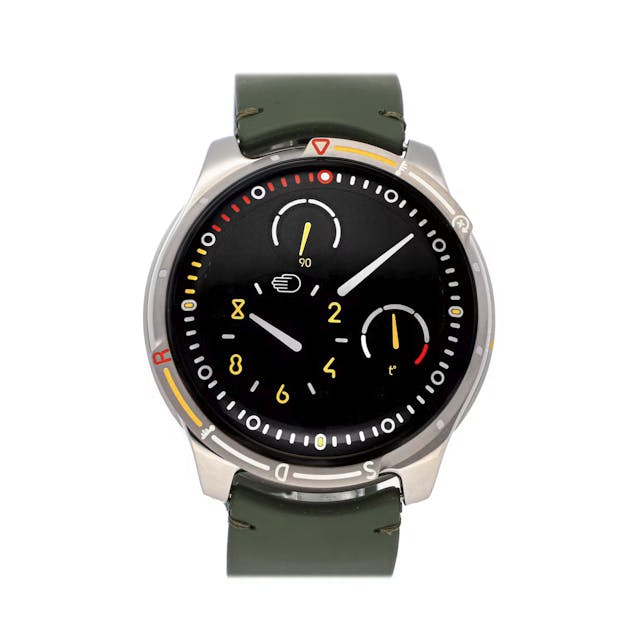
Which of these watches appeals to you, and what other watches would you add to this list for the person that loves cars, car culture, and motorsports? What do you think it is about watches and cars that appeals so often to the same people?


How could you leave out the original Heuer Carrera chronograph from the 60’s and 70’s?
This was my first entry on Hagerty, and I wasn’t sure how much copy volume they’d allow. A longer article might have mentioned the Carrera. I wanted to have one mainstream watch model before examining the less common watches in the space. If I had to choose between that mainstream car-adjacent watch being the Daytona or the Carrera, I find the Daytona has stronger roots. Heuer has tons of car-relevant watches from the 60s, 70s, and 80s, and the Daytona just overshadows both those and the car-themed Speedmasters that Omega releases from time to time.
Best,
Tim
Ditto
I still prefer my Heuer Autovia from 1978, though it does weigh a ton.